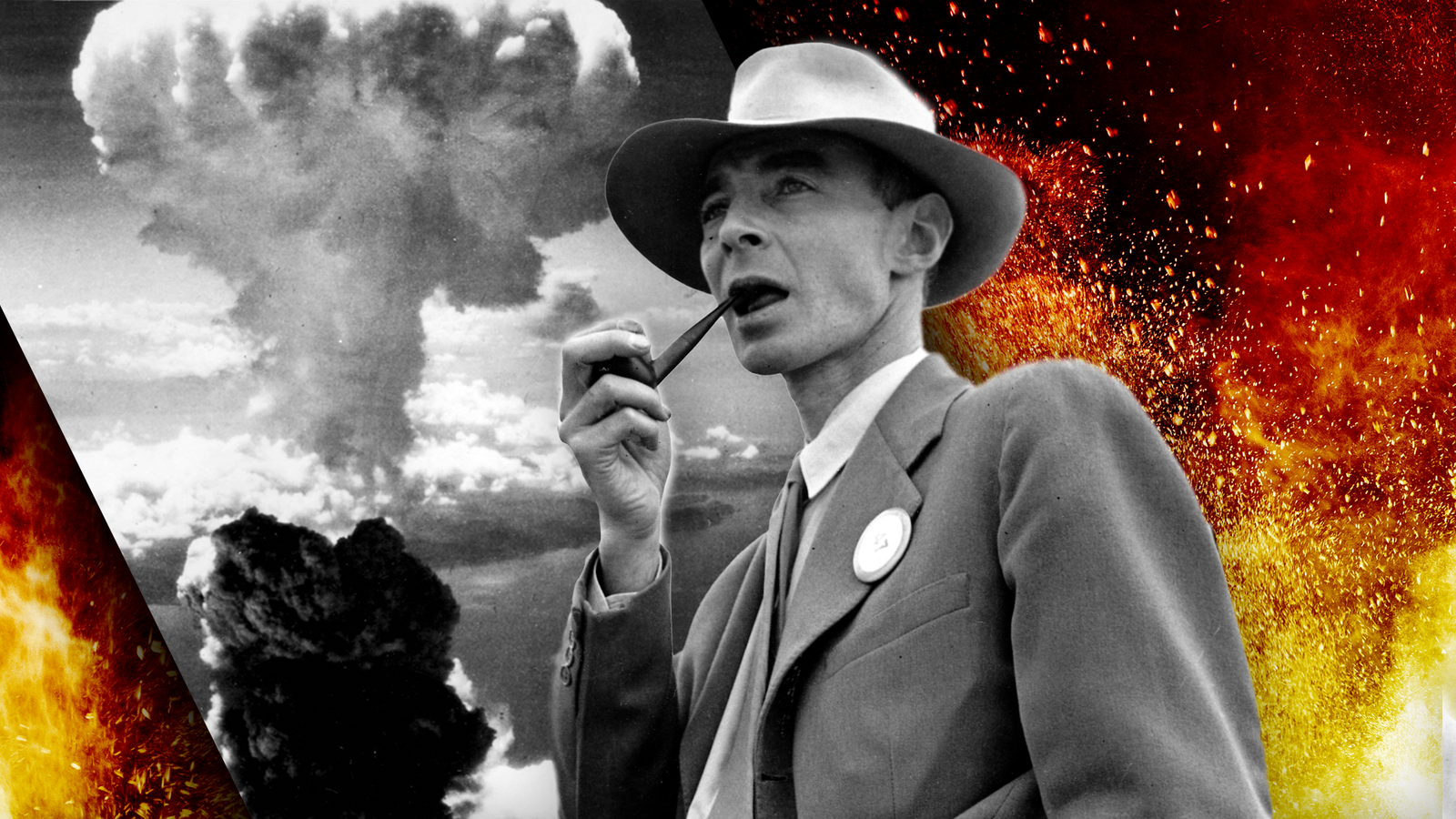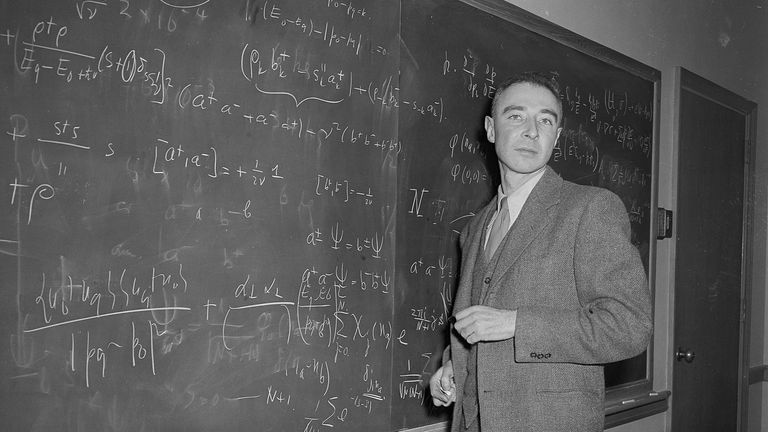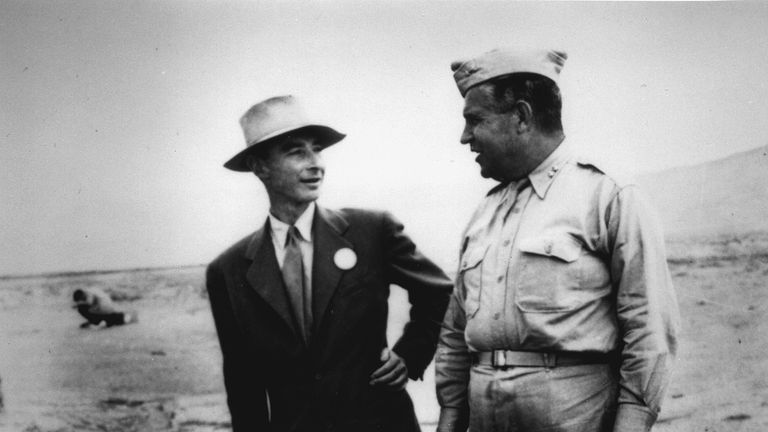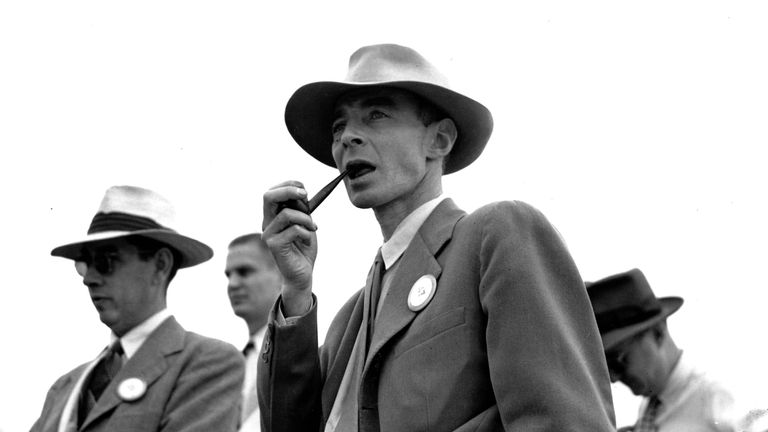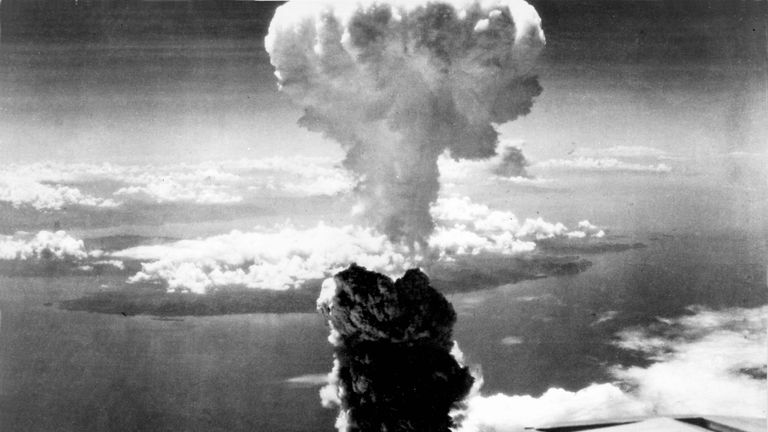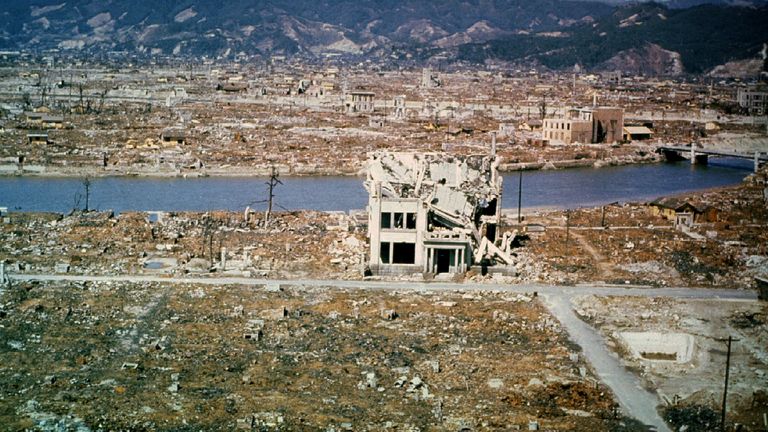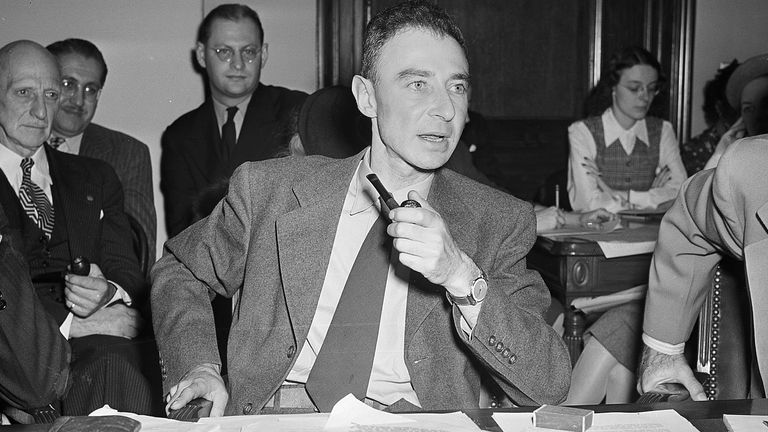Each time Vladimir Putin raises the spectre of nuclear confrontation, the trail ultimately leads back to one man.
Eighty years before the Russian president invaded Ukraine, and brought the potential of such weapons back to mainstream attention, J Robert Oppenheimer was recruited to lead a team that would construct the world’s first atomic bombs.
Ukraine war – follow the latest developments
The Manhattan Project, set up during the Second World War in 1942, was guided by fear that if the US and its allies didn’t make them first, Hitler’s Nazi scientists would.
A left-wing theoretical physicist not known for his leadership qualities or laboratory acumen, the American was an unconventional pick but proved a devastatingly effective one.
As blockbuster biopic Oppenheimer hits cinemas, Sky News looks at how the father of the atomic bomb still shapes the world decades after his creation was deployed.
Read more:
‘The danger never goes away’
What is the Doomsday Clock and how does it work?
An unusual recruitment
Oppenheimer was appointed by General Leslie Groves, the project’s military leader, to head up Site Y – a secret weapons research facility at Los Alamos, New Mexico.
But there were, as Oppenheimer biographer Professor Ray Monk puts it, “all sorts of reasons” not to appoint him, notably perceived association with communist organisations that had made him a suspect of the FBI.
Born to a Jewish family in New York in 1906, his student years had seen him drawn to the left as Germany’s fascist regime saw friends and relatives oppressed and forced to flee.
During studies at Harvard, Cambridge, and Germany‘s Gottingen university in the 1920s, he was known for being a “disaster in the laboratory”. Of his time studying physics at Harvard, Oppenheimer himself said: “My feeling about myself was always one of extreme discontent.”
He may have been unconvincing in the lab, but found his calling as a university lecturer in California. His ability to explain complex science in a relatively straightforward and compelling way proved key to impressing Groves, who interviewed countless scientists before a chance meeting with Oppenheimer.
Crucially, he also recognised the need for urgency.
Prof Monk says: “Oppenheimer knew Heisenberg, one of the greatest scientists in the world, who he worked with at Gottingen, was leading the Nazi bomb project and was worried they would get one before the Allies.
“He was in no doubt at all – the duty of all scientists in the US, and the allied countries, was building a bomb first.”
Building the bomb
Los Alamos was one of three sites critical to the development of the atomic bomb.
The others were a factory in Hanford, Washington, where plutonium was made; and a hidden base in Oak Ridge, Tennessee, for enriching uranium.
The two elements would act as fuel for the bombs made at Los Alamos, two of which would be dropped on the Japanese cities of Nagasaki and Hiroshima in August 1945.
Cynthia C Kelly is founder and president of the Atomic Heritage Foundation, dedicated to the preservation of the Manhattan Project and crucial to having the three sites gain national park status in the US.
“It was a first-of-a-kind effort across the board,” she says of the Manhattan Project, named after the New York City district where it was founded.
With the city that never sleeps deemed too busy for such a secretive initiative, the three laboratories were set up in isolated places far away from urban centres and the coast. They brought together geniuses from across America and overseas – including Britain and some who fled Nazi Germany – into one single-minded pursuit.
Click to subscribe to Backstage wherever you get your podcasts
“It required creative minds from the machinists to the craftsmen – everything had to be perfect,” Kelly adds, with a “classic absent-minded professor” at the heart of it.
“They had to take this energy, which had been uncontrolled up to now, figure out how to control it, and package it tightly enough to fit in the bomb bay of an aeroplane that could transport it and drop it.
“They had little confidence in harnessing this technology in time for the end of the war.”
Becoming Death
But harness it they did – and the world would change forever.
The first atomic bomb test in New Mexico happened on 16 July 1945, after which Oppenheimer uttered a line that, along with his trademark fedora and pipe, has become quintessential to his public image.
“Now I am become Death, the destroyer of worlds,” he observed after the so-called Trinity Test, quoting a sacred Hindu text in a reminder of his acumen as a philosopher as well as a scientist.
A few weeks after, death followed on an unimaginable scale. On 6 August, a uranium-based bomb named Little Boy was detonated over Hiroshima; and another, Fat Man, was dropped on Nagasaki three days later.
Both cities were left unrecognisable, 200,000 people died, and Japan surrendered. Oppenheimer was shaken.
“Right up until the dropping of the bomb on Hiroshima, he had no moral qualms whatsoever,” says Prof Monk.
“Even when the Germans surrendered (on 7 May 1945), and it was obvious the Americans were still going to use the bomb against the Japanese, he had no qualms.
“But he thought one demonstration of the awesome power of this weapon was enough.”
A new world
Despite its undoubted role in ending the Second World War, which cost the lives of some 90 million people, Oppenheimer was changed by the atomic bomb, believing it made the prospect of future conflict “unendurable”.
“It has led us up those last few steps to the mountain pass; and beyond there is a different country,” he said in 1946, later signalling his opposition to his government’s plan to develop even bigger nuclear weapons.
Oppenheimer was ignored and held in deep suspicion, and his security clearance at the Atomic Energy Commission eventually rescinded. He died of lung cancer in 1967 with none of the power he once yielded.
Nuclear weapons have not been used again, but the threat lingers. America and Russia’s arsenals are far smaller than their Cold War peak, but they hold 90% of an estimated global stockpile of 13,000 weapons.
Other nuclear powers include China, India, Pakistan, and North Korea. Like Putin, Kim Jong Un has on several occasions threatened to use them. The Nuclear Threat Initiative, an organisation focused on reducing nuclear and biological threats, says the world could be “sleepwalking into a nuclear disaster”.
Ever since Oppenheimer witnessed the Trinity Test in the New Mexico desert, Cynthia C Kelly says there’s been “no way to put the genie back in the bottle”.
Beyond the mountain
While Oppenheimer failed in his post-war efforts, his work is the best example world leaders have of why they wouldn’t want to risk “mutually-assured destruction” by launching a nuclear weapon.
Two cities devastated beyond recognition have seemingly served as the ultimate deterrence.
“Oppenheimer was invited to say he regretted developing the atomic bomb many times, most prominently when he visited Japan, and his answer was always no,” says Prof Monk.
“It can be argued the fact the weapons have never been used again shows deterrence works.”
Read more:
What nuclear weapons does Russia have?
Beyond deterrence, the Manhattan Project also unleashed an era of science and innovation still being felt today, including nuclear energy vital to weaning ourselves off greenhouse gases.
Last year, American scientists performed the first-ever nuclear fusion experiment to achieve net energy gain, paving the way for a “clean energy source that could revolutionise the world”.
Some experts have called for a Manhattan Project-style initiative to combat climate change, leveraging the same urgency and determination to tackle a crisis that threatens us all. The startling rise of artificial intelligence, already compared to the threat of nuclear weapons by its very creators, may present another such opportunity.
Unfortunately, nothing seems to focus the minds quite like war.
“Weapons are one part of the nuclear story, and that will be with us until we blow ourselves up,” says Kelly.
“Hopefully that won’t happen and, as Oppenheimer put it, we can see beyond the mountain.”
